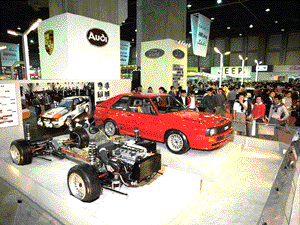 |
"The Advanced Auto, Brightening Our Horizons"
The theme of this year s motor show was "Vehicles, Brighten up, and
Growing World." Japanese automobiles were entering a new era. Japan overcame the severe trials of the 1970s, and through those hardships became the world s largest production and export country. Moreover, Japanese automobiles came to be well received by the world s consumers for their high quality and value.
Scrutiny of combustion theory, countless experiments, and huge R & D investments resulted in clearing the world s severest emission controls and at the same time led to volume production of small car engines, the most efficient engines in the world, through the use of many techniques learned in the process. The results, no longer a clumsy copy of foreign technology as critics had said before, represented vast technological potential, since they were created by
original devices and efforts.
Times favored the Japanese auto industry. The combination of electronic/mechatronic innovations -- such as integrated circuits, micro-processors, and one-tip computers -- and automobile technologies brought further progress and performance in Japanese automobiles. Wide use of electronics in such basic components as engine controls, brakes, suspensions, and transmissions, and in equipment such as air conditioners, sensors and motors helped change the concept of what a vehicle is.
Furthermore, remarkable results were seen in performance through the use of new materials: engineering plastics and new ceramics, and the quest for maintenance-free parts. Japanese automobiles were breaking a new path by developing various models to meet users needs based on new technological advancements. Manufacturers believed these lively, wonderful vehicles should be delivered to the world for the people to enjoy. The theme of the 25th motor show developed from this wish. The year 1983 saw lingering worldwide recession and consequently sluggish domestic car demand. However, the rapid technological advancements shown at the motor show were amazing. Exhibition of prototype cars was abundant in number and variety. Most were not so much dream cars as practical cars that could actually run. New technologies incorporated in these cars created images of tomorrow s vehicle. Their characteristics suggested new vehicle technology for the near-future.
Especially conspicuous was the emphasis placed by Toyota, Nissan, and Mazda on the display of high-tech prototypes to show vehicle technology of the near-future. For example, Toyota displayed the FX-1 show car, loaded with the latest technologies. Its twin-cam 24 engine was equipped with water-cooled intercooler, twin turbo, variable valve timing, variable intake system, and variable exhaust system. The body with a wind resistance value of 0.25, had a crystal canopy and all pillars were covered with glass. Moreover, this car was equipped with electronically controlled suspension which altered body height according to cruising conditions. Another exhibit was the midship sports SV-3 that had attracted much attention from car enthusiasts. This car, displayed for reference, later went on sale as the MR 2.
While Toyota showed feasible technologies, Nissan proposed how vehicles should be from the 1980s into the 21st century in the form of NX-21. This car had "gull wing" doors, and had a wind resistance value of 0.25. Despite its low body, the car was roomy space enough for four passengers to ride comfortably. The secret lay in mounting a compact, ceramic gas turbine in the rear. Also, electronic technology was fully exploited, and the design was so rational that no switches were found.
Mazda displayed the MX-2 targeting the 1990s. This was an avant-garde prototype car using every imaginable technology. A four-wheel steering system allowed same and reverse-phase steering on front and rear wheels. Using reverse-phase reduced the turning radius, while same phase allowed transverse motion. Later, a similar system was put to practical use by Mazda and a number of other companies.
The ceramics engine which Isuzu exhibited for reference was superior in terms of heat-resistance, friction-resistance, and rust-resistance compared to an iron engine. This engine attracted attention as an engine for the next age. Noticeable among new models was the Santana, which Nissan produced in Japan in cooperation with VW of Germany, the Subaru J10, the Mazda Familia Cabriolet, and the Mitsubishi Lancer EX1800GSR Intercooler Turbo. A popular topic among young people was the new turbo version Honda City, which had been much talked about because of its increased height, which contradicted the general trend among Japanese automakers toward lower bodies. The turbo boom spread to the mass-market sector. The Daihatsu Charade Turbo and the Suzuki Cervo turbo had already made their debuts.
Bon van, Alto, Rex Combi, and Mira, midget cars that had attracted women at the previous show because of their low prices as "patience cars," were equipped with four-wheel drive. The Rex Combi was also equipped with a turbo. Thus, these cars were improved and their fans included more young men.
This motor show was also significant in that Hino, Nissan, and Mitsubishi exhibited super deluxe double-decker buses for reference.
The foreign vehicle hall accommodated 1.5 times as many exhibits as at the previous show with participation from 28 companies. The hall thrived in terms of the quantity and quality of exhibits. Total exhibits including those by domestic makers numbered 945, more than the previous show. Visitors numbered 1,200,400 including 26,625 foreigners. Press journalists counted 288.
|